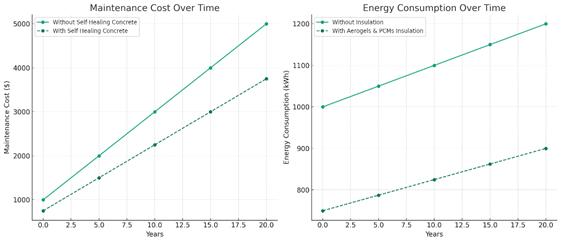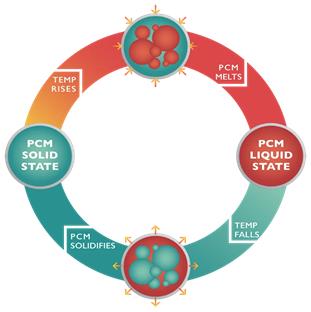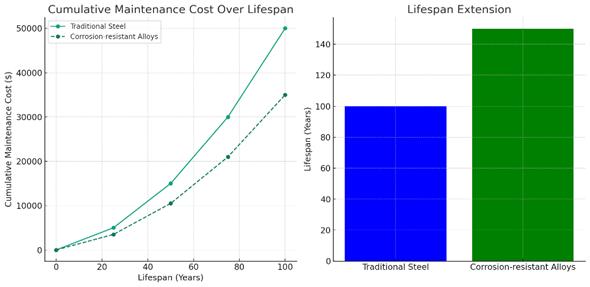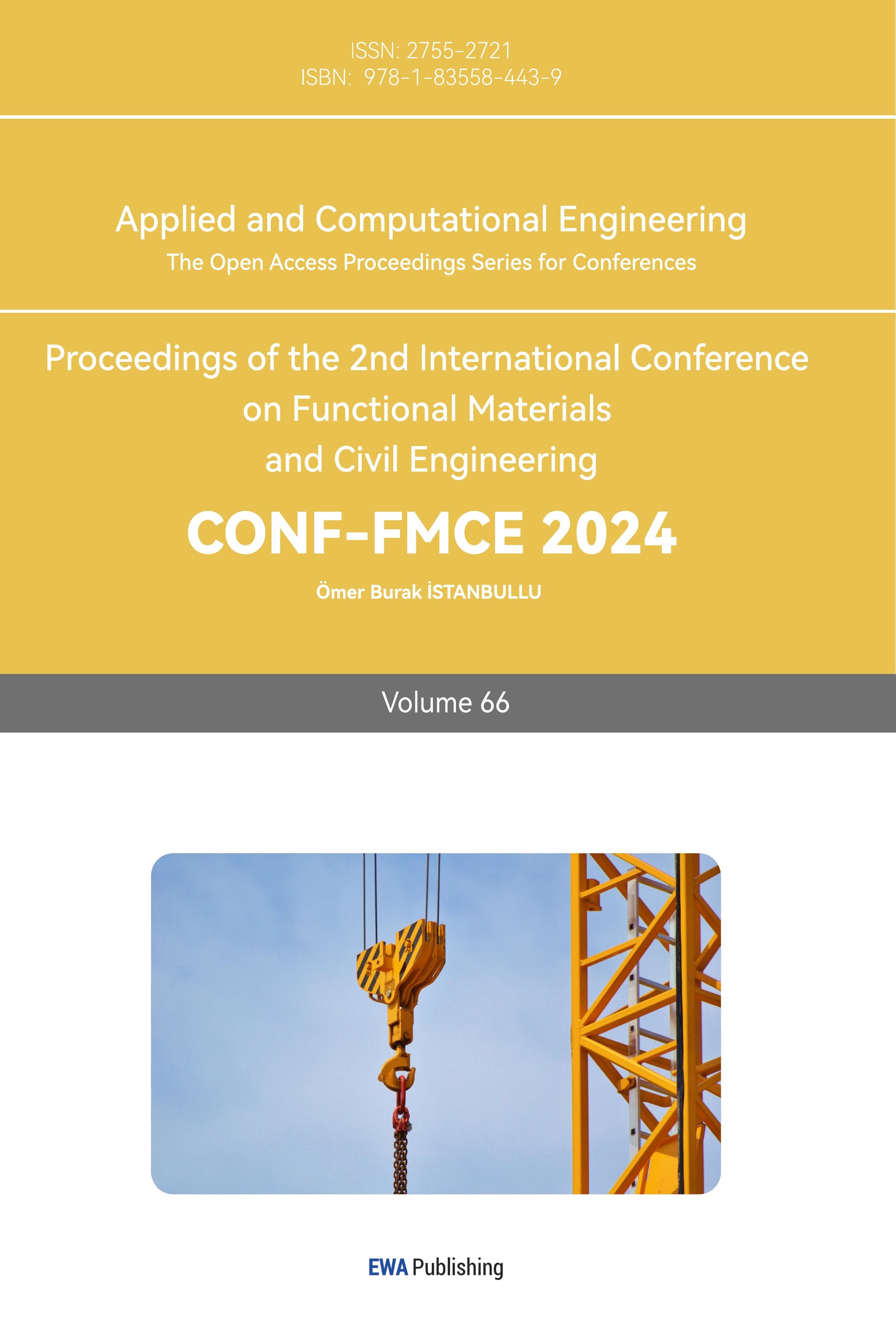1. Introduction
In the quest for sustainable development, the construction and environmental management sectors are at the forefront of adopting innovative technologies and materials. This movement is driven by the urgent need to address environmental challenges, including resource depletion, pollution, and the impacts of climate change. Advanced materials such as self-healing concrete, energy-efficient insulation materials, and recycled composites are revolutionizing the construction industry by enhancing durability, reducing energy consumption, and minimizing the ecological footprint of new structures. Concurrently, innovations in water and wastewater treatment technologies, including membrane filtration advances, photocatalytic water purification, and bioremediation techniques, are setting new standards for environmental stewardship by improving water quality and conserving this vital resource [1]. The integration of smart sensing technologies and the development of earthquake-resistant designs further exemplify the industry’s shift towards resilience and sustainability, ensuring that infrastructures not only last longer but also better withstand natural disasters. Moreover, the environmental impact of construction practices is being meticulously evaluated through lifecycle analysis, promoting the use of materials and methods that contribute positively to the environment. The adoption of sustainable urban drainage systems and green roof and wall systems illustrates a growing commitment to mitigating urban environmental issues, such as flooding and the urban heat island effect, thereby enhancing urban livability. Underpinning these technological and material innovations are robust policy and regulatory frameworks that encourage sustainable practices. International standards for sustainable materials, regulations for water quality and conservation, and incentives for green building practices are instrumental in driving the adoption of sustainable construction methods and environmental management strategies. These policies not only facilitate the transition towards sustainability but also underscore the interconnectedness of technological innovation, environmental responsibility, and regulatory support in building a more sustainable future. This article explores these themes, highlighting the advancements, challenges, and opportunities at the intersection of construction technology, environmental management, and policy frameworks.
2. Advanced Materials for Sustainable Construction
2.1. Self-Healing Concrete
Self-healing concrete utilizes biological or chemical agents encapsulated within the concrete matrix that activate upon the formation of cracks. Bacterial spores, alongside a calcium-based nutrient source, are one such agent. Upon water ingress, these spores germinate, consuming the calcium lactate to precipitate calcium carbonate, effectively sealing the crack. Quantitative analysis involves assessing the crack-sealing efficiency over time, using metrics such as crack width reduction and regain in compressive strength. Studies have shown that self-healing concrete can improve the lifespan of concrete structures by up to 30% as shown Figure 1, significantly reducing the environmental and economic costs associated with maintenance [2]. Mathematical models to predict the self-healing efficiency incorporate factors such as spore concentration, encapsulation material permeability, and environmental conditions, following a modified diffusion-reaction equation to simulate the healing process.
The development of energy-efficient insulation materials like aerogels and Phase Change Materials (PCMs) represents a significant advancement in building thermal management as shown in Figure 2. Aerogels, with their extremely low thermal conductivity (as low as 0.015 W/mK), offer superior insulation with minimal thickness. PCMs contribute by absorbing or releasing heat as they change phase, effectively buffering temperature fluctuations. Detailed mathematical modeling of thermal performance for these materials involves solving the heat conduction equation, considering the unique properties of aerogels and the enthalpy change of PCMs during phase transitions. Such models can predict energy savings from reduced HVAC load, with simulations indicating potential reductions in energy consumption for heating and cooling by up to 25% in varied climatic conditions.

Figure 1. The Impact of Self-Healing Concrete and Energy-Efficient Insulation Materials
/

Figure 2.The Phase Change Materials (source: microteklabs)
2.2. Recycled Composite Materials
Recycled composite materials, made from plastics and other recyclable composites, are being increasingly used in construction due to their sustainability and mechanical properties. The environmental benefits of these materials are quantified through Life Cycle Assessment (LCA) methodologies, which consider the reduced emission of CO2 and lower energy consumption throughout the material’s lifecycle compared to traditional construction materials. Computational models analyzing the mechanical properties of recycled composites focus on tensile strength, flexural strength, and durability under environmental stressors.
3. Innovation in Water and Wastewater Treatment Technologies
3.1. Membrane Filtration Advances
Recent advancements in membrane technology have led to the development of novel materials and configurations that significantly enhance the efficiency of water and wastewater treatment processes. Thin-film composite (TFC) membranes, for instance, offer improved rejection of contaminants due to their fine-tuned pore size and surface chemistry [3]. Mathematical models of filtration efficiency for these membranes incorporate parameters such as pore size distribution, membrane surface charge, and hydrodynamic conditions, following the extended Hagen-Poiseuille equation to predict flux and rejection rates. Cost-benefit analyses, integrating the capital and operational costs with the expected lifespan and maintenance requirements, reveal that these advanced membranes can reduce overall treatment costs by up to 20%, with the added benefit of increased contaminant removal efficiency. The models also consider the reduced energy consumption and chemical usage as key factors contributing to the economic viability of these systems.
3.2. Photocatalytic Water Purification
The development of photocatalytic materials, particularly titanium dioxide (TiO2), has opened new avenues for water purification technologies. When exposed to UV light, TiO2 catalyzes the degradation of organic pollutants, transforming them into less harmful compounds. Quantitative analysis of degradation rates involves applying the Langmuir-Hinshelwood kinetics model, which describes the relationship between the concentration of pollutants and the rate of photocatalytic degradation.
This model has been refined to account for various factors influencing the efficiency of photocatalysis, including light intensity, catalyst surface area, and pollutant initial concentration. Studies have shown that doping TiO2 with metals like silver can enhance photocatalytic activity, resulting in up to a 50% increase in degradation rates for certain pollutants. These findings underscore the potential of photocatalytic materials for large-scale water purification applications, offering a sustainable alternative to traditional treatment methods.
3.3. Bioremediation Techniques
Bioremediation, the use of living organisms to degrade or remove pollutants from water and soil, has gained traction as a sustainable and effective treatment method. Engineered bacteria and genetically modified plants have been developed to enhance the natural bioremediation process, targeting specific contaminants such as heavy metals and organic pollutants. Mathematical modeling of pollutant removal kinetics for these engineered organisms employs the Monod equation, which correlates the growth rate of microorganisms with the concentration of pollutants, providing insights into the efficiency and scalability of bioremediation processes.
These models help to optimize the conditions under which bioremediation is most effective, including nutrient availability, temperature, and pH. Moreover, scalability considerations are addressed through models predicting the performance of bioremediation in field-scale applications, taking into account the interactions between different species of microorganisms and the physical characteristics of the environment [4]. The application of these models has demonstrated the potential for engineered bioremediation techniques to achieve up to a 90% reduction in pollutant levels, making it a viable option for large-scale water and soil decontamination projects.
4. Enhancing Durability and Lifespan of Civil Infrastructures
4.1. Corrosion-resistant Alloys
The development of corrosion-resistant alloys for construction has significantly advanced the durability of infrastructure. Alloys such as stainless steel, nickel-based alloys, and weathering steel are engineered to form a stable, protective oxide layer that minimizes corrosion when exposed to environmental conditions. Quantitative assessments of these materials have shown that they can extend the lifespan of structures by up to 50% compared to traditional carbon steel.
This extension translates into substantial maintenance cost reductions, with economic models estimating savings in the range of 20-30% over the lifetime of a structure as shown Table 2. The application of electrochemical impedance spectroscopy (EIS) and salt spray testing provides a quantitative measure of the alloys’ corrosion resistance, supporting their selection in critical infrastructure projects. Moreover, lifecycle cost analysis (LCCA) models incorporate initial costs, maintenance intervals, and expected lifespan to quantify the total cost of ownership, affirming the economic viability of corrosion-resistant alloys in long-term infrastructure investments.

Figure 3. Traditional Steel versus Corrosion-Resistant Alloys in Infrastructure
4.2. Smart Sensing Technologies
The integration of smart sensors into civil infrastructure enables real-time monitoring and predictive maintenance, significantly enhancing structural health management. Technologies such as fiber optic sensors, wireless sensor networks, and Internet of Things (IoT) devices collect data on various parameters, including strain, temperature, moisture, and vibration. Data analytics models leverage machine learning algorithms to analyze this data, identifying patterns and anomalies that may indicate potential structural issues. Predictive models, often based on neural networks or support vector machines (SVM), use this data to forecast structural health and recommend maintenance actions before critical failures occur. Quantitative studies have demonstrated the effectiveness of these technologies in reducing unplanned downtime by up to 40% and maintenance costs by up to 25%. Furthermore, the deployment of these sensors and the subsequent data analysis enable a transition from traditional scheduled maintenance to a more efficient, condition-based maintenance strategy, optimizing resource allocation and extending the service life of infrastructure components.
5. Environment and Mitigation
5.1. Lifecycle Analysis of Building Materials
Lifecycle Analysis (LCA) of building materials involves a comprehensive assessment from raw material extraction through manufacturing, transportation, use, and end-of-life disposal or recycling. This process quantifies the environmental impacts, including greenhouse gas emissions, energy use, water consumption, and waste generation. For instance, the carbon footprint of concrete, one of the most widely used building materials, is critically evaluated, considering its substantial CO2 emissions during cement production [5]. Quantitative data from LCA studies reveal that substituting a portion of Portland cement with fly ash or slag can reduce the CO2 emissions by up to 15-20%. Similarly, the analysis of timber, a renewable resource, shows lower life cycle energy consumption and carbon footprint compared to traditional materials, underlining the importance of sustainable forest management practices. These assessments utilize ISO 14040/14044 standards, employing software tools like SimaPro or GaBi to model environmental impacts based on inventory data, providing a basis for selecting materials that reduce the overall environmental footprint of construction projects.
5.2. Green Roof and Wall Systems
Green roofs and walls contribute to urban sustainability by providing insulation, reducing heat island effects, improving air quality, and supporting biodiversity. Quantitative analyses of these systems focus on their capacity to regulate building temperatures, with studies showing that green roofs can reduce the demand for air conditioning by up to 75% during peak summer months. This is achieved through the combined effects of shading, evapotranspiration, and thermal mass, which are quantified using energy balance equations that account for solar radiation, heat fluxes, and moisture content [6]. Air quality improvements are evaluated through the quantification of particulate matter (PM) capture and the reduction of pollutants such as NOx, with green roofs and walls showing a potential to reduce PM concentrations by up to 20% in surrounding areas. Biodiversity benefits are assessed by comparing species richness and abundance on green infrastructures with conventional roofs, indicating a significant increase in urban biodiversity These quantitative assessments are supported by field measurements and mathematical modeling, providing a robust framework for evaluating the environmental benefits of green roof and wall systems in urban areas [7].
6. Conclusion
The confluence of advanced materials, innovative water treatment technologies, and robust policy frameworks represents a pivotal shift toward sustainable construction and environmental management. The quantitative analysis presented underscores the significant environmental, economic, and societal benefits of adopting these innovations. Self-healing concrete, energy-efficient materials, and recycled composites demonstrate the potential to reduce the environmental impact of construction activities. Similarly, advancements in water treatment technologies offer scalable solutions for improving water quality and conservation [8]. The integration of smart sensors and resilient design strategies enhances infrastructure longevity and safety. Critical to the widespread adoption of these innovations are supportive policy and regulatory frameworks, which not only incentivize sustainable practices but also ensure compliance with international standards for environmental protection [9]. Moving forward, a continued focus on interdisciplinary research, coupled with strategic policy interventions, will be essential in addressing the complex challenges of sustainable development, ensuring a resilient and environmentally harmonious future.
References
[1]. De Vries, Bert JM. Sustainability science. Cambridge University Press, 2023.
[2]. Geels, Frank W., Florian Kern, and William C. Clark. “Sustainability transitions in consumption-production systems.” Proceedings of the National Academy of Sciences 120.47 (2023): e2310070120.
[3]. Demastus, James, and Nancy E. Landrum. “Organizational sustainability schemes align with weak sustainability.” Business Strategy and the Environment (2023).
[4]. Adilxodjayev, Anvar. “MODERN METHODS OF RESERCH OF CONSTRUCTION MATERIALS.” TOSHKENT-2023 (2023).
[5]. Kalali, Ehsan Naderi, et al. “A critical review of the current progress of plastic waste recycling technology in structural materials.” Current Opinion in Green and Sustainable Chemistry (2023): 100763.
[6]. Seif, Rania, Fatma Zakaria Salem, and Nageh K. Allam. “E-waste recycled materials as efficient catalysts for renewable energy technologies and better environmental sustainability.” Environment, Development and Sustainability (2023): 1-36.
[7]. Schröder, Patrick, et al. “Making policy work for Africa’s circular plastics economy.” Resources, Conservation and Recycling 190 (2023)
[8]. Mell, Ian C. “Green infrastructure: concepts and planning.” FORUM ejournal. Vol. 8. No. 1. Newcastle, UK: Newcastle University, 2008.
[9]. Gill, Susannah E., et al. “Adapting cities for climate change: the role of the green infrastructure.” Built environment 33.1 (2007): 115-133.
Cite this article
Liu,X.;Zhao,A. (2024). Advancing sustainability in construction and environmental management about innovative materials, technologies, and policy frameworks. Applied and Computational Engineering,66,107-112.
Data availability
The datasets used and/or analyzed during the current study will be available from the authors upon reasonable request.
Disclaimer/Publisher's Note
The statements, opinions and data contained in all publications are solely those of the individual author(s) and contributor(s) and not of EWA Publishing and/or the editor(s). EWA Publishing and/or the editor(s) disclaim responsibility for any injury to people or property resulting from any ideas, methods, instructions or products referred to in the content.
About volume
Volume title: Proceedings of the 2nd International Conference on Functional Materials and Civil Engineering
© 2024 by the author(s). Licensee EWA Publishing, Oxford, UK. This article is an open access article distributed under the terms and
conditions of the Creative Commons Attribution (CC BY) license. Authors who
publish this series agree to the following terms:
1. Authors retain copyright and grant the series right of first publication with the work simultaneously licensed under a Creative Commons
Attribution License that allows others to share the work with an acknowledgment of the work's authorship and initial publication in this
series.
2. Authors are able to enter into separate, additional contractual arrangements for the non-exclusive distribution of the series's published
version of the work (e.g., post it to an institutional repository or publish it in a book), with an acknowledgment of its initial
publication in this series.
3. Authors are permitted and encouraged to post their work online (e.g., in institutional repositories or on their website) prior to and
during the submission process, as it can lead to productive exchanges, as well as earlier and greater citation of published work (See
Open access policy for details).
References
[1]. De Vries, Bert JM. Sustainability science. Cambridge University Press, 2023.
[2]. Geels, Frank W., Florian Kern, and William C. Clark. “Sustainability transitions in consumption-production systems.” Proceedings of the National Academy of Sciences 120.47 (2023): e2310070120.
[3]. Demastus, James, and Nancy E. Landrum. “Organizational sustainability schemes align with weak sustainability.” Business Strategy and the Environment (2023).
[4]. Adilxodjayev, Anvar. “MODERN METHODS OF RESERCH OF CONSTRUCTION MATERIALS.” TOSHKENT-2023 (2023).
[5]. Kalali, Ehsan Naderi, et al. “A critical review of the current progress of plastic waste recycling technology in structural materials.” Current Opinion in Green and Sustainable Chemistry (2023): 100763.
[6]. Seif, Rania, Fatma Zakaria Salem, and Nageh K. Allam. “E-waste recycled materials as efficient catalysts for renewable energy technologies and better environmental sustainability.” Environment, Development and Sustainability (2023): 1-36.
[7]. Schröder, Patrick, et al. “Making policy work for Africa’s circular plastics economy.” Resources, Conservation and Recycling 190 (2023)
[8]. Mell, Ian C. “Green infrastructure: concepts and planning.” FORUM ejournal. Vol. 8. No. 1. Newcastle, UK: Newcastle University, 2008.
[9]. Gill, Susannah E., et al. “Adapting cities for climate change: the role of the green infrastructure.” Built environment 33.1 (2007): 115-133.









